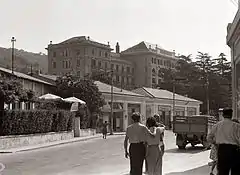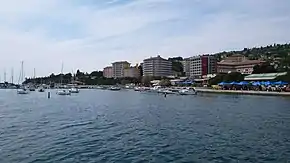Portorož
Portorož (pronounced [pɔɾtɔˈɾoːʃ] (![]() listen); Italian: Portorose, literally "Port of Roses") is a Slovenian Adriatic seaside resort and spa town located in the Municipality of Piran in southwestern Slovenia. Its modern development began in the late 19th century with the vogue for the first health resorts. In the early 20th century Portorož became one of the grandest seaside resorts in the Adriatic, along with Abbazia, Lido and Grado, then as part of the Austrian Littoral.[2] It is now one of Slovenia's major tourist areas.[3] Located in the centre is the Palace Hotel, once one of the most important resorts for the Austro-Hungarian monarchy, and currently one of the finest hotels between Venice and Dubrovnik.[4]
listen); Italian: Portorose, literally "Port of Roses") is a Slovenian Adriatic seaside resort and spa town located in the Municipality of Piran in southwestern Slovenia. Its modern development began in the late 19th century with the vogue for the first health resorts. In the early 20th century Portorož became one of the grandest seaside resorts in the Adriatic, along with Abbazia, Lido and Grado, then as part of the Austrian Littoral.[2] It is now one of Slovenia's major tourist areas.[3] Located in the centre is the Palace Hotel, once one of the most important resorts for the Austro-Hungarian monarchy, and currently one of the finest hotels between Venice and Dubrovnik.[4]
Portorož
Portorose | |
|---|---|
.jpg.webp) Portorož in late August 2009 | |
 Portorož Location in Slovenia | |
| Coordinates: 45°30′59.88″N 13°34′47.89″E | |
| Country | |
| Traditional region | Slovenian Littoral |
| Statistical region | Coastal–Karst |
| Municipality | Piran |
| Area | |
| • Total | 2.97 km2 (1.15 sq mi) |
| Elevation | 31.2 m (102.4 ft) |
| Population (2002) | |
| • Total | 2,849 |
| [1] | |
The settlement and its surrounding areas are served by Portorož International Airport which is located in the nearby village of Sečovlje.
History
The history of the settlement is directly connected to that of the neighbouring town of Piran, with Illyrian settlers already living there in the prehistoric era. They were followed by Celtic tribes, which were later conquered and annexed by the Roman Empire in 178 B.C. Archaeological finds suggest that in this period many farms and villas, also named villae rusticae, were built in the area. A large development of the area followed only after the demise of the empire, with enlargement of the number of settlers seeking shelter from attacks by the Barbarians.
In the 7th century, the area was a part of the Byzantine Empire. Due to increasing dissatisfaction with the feudal rule, as well as the rising power of the Venetian Republic, the settlement of Pirano signed a trade treaty with Venice, which included a lesser degree of autonomy.
.jpg.webp)
One of the first religious orders who came to this area was the Benedictines. In the 12th century, the broader region already had four monasteries and even more churches. Among those, one of the oldest was the church of Our Lady of the Rosary, which stood by the bay in the beginnings of the 13th century. Its name was Sancta Maria Roxe or S. Maria delle Rose, and in 1251 the bay was named by it Portus sanctae Mariae de Rosa.
One of the most important roles in the history of the settlement was the monastery of Saint Laurence, where the Benedictines healed rheumatic illnesses, ascites and other diseases with concentrated saltwater and saline mud. In 1210, the area was overtaken by the Patriarchy of Aquileia.
In the 13th century, Pirano entered a brief war from December 1282 to January 1283, in which it was defeated by the Venetian Republic.
.jpg.webp)
During the second Venetian rule, it was, contrary to other towns on the Istrian peninsula, loyal to Venetian rule, and as such gained special privileges within the republic, which in turn caused the local economy to boom. In 1797, Venetian rule came to a close as the Austrian Empire took over the area for a brief period until 1806. From 1806 to 1813, the entire Istrian Peninsula became part of the Illyrian Provinces.
A period of economic growth followed during the second Austrian rule, with enlargement of trade and locally important salt pans in nearby Lucija and Sečovlje. In the aftermath of the Great War, the Treaty of Rapallo determined the Istrian peninsula to be from that point on a part of the Kingdom of Italy.
Under the royal and then fascist rule, the area found itself amidst economic decline and civil conflicts between the populace and the state. In World War II, the area had not seen much action, although the important industrial hub of Trieste suffered multiple bombings. In the aftermath of the war, the settlement found itself in the United Nations-administered Free Territory of Trieste. After the dissolution of the Trieste state it became a part of Yugoslavia.[5]
Economy
The economy of Portorož is mainly based on tourism and the gambling industry. The facilities include a marina,[6] numerous sporting facilities and several casinos, along with many hotels and apartment complexes.
Tourism development
In the second half of the 19th century, the leaders of the Pirano municipality and local doctors decided to stimulate tourism in the region, by offering health treatment by concentrated salt water and salina mud. From 1879 onward, Dr Giovanni Lugnano the first to offer such treatment to various visitors.
In 1885, after several years of successful start of a new branch of industry, constructions of new complexes and villas began, and, in 1890, the predecessor of the famous Hotel Palace was built.
In 1908, Orazio Pupini, a prominent Austrian doctor with a notable treatment history opened a sanatorium. He was also the main doctor of the Austrian Railways, and a member of the Austrian Doctors' Association. In 1902, the Parenzana railway system was introduced which increased the popularity of the region, but was later dissolved because of decreased interests.

In 1909, the era of construction of private villas ended with opening of a much bigger building for standards at the time; the Palace Cur Hotel, later known as the Palace Hotel. At the initial opening ceremony, in 1910, the Palace Hotel was named "the most beautiful hotel on the Adriatic coast". The hotel was equipped with the most modern therapeutic accessories, and a casino was built for important guests.
The thriving community was halted by World War I, and a few years after the war (in which they came under Italian rule) in 1928 they included a new electric therapy among their treatment programmes. In the interwar period the settlement was slowly regaining its former glory when World War II severely crippled it again. The crisis lasted until 1968 when renovations and new constructions under the new entity of Yugoslavia began to take place along the whole region. In this time they began to build the settlement's infrastructure with the casino doing the bulk of the investments in reconstructing the sports airfield in nearby Sečovlje and building the multi-purpose auditorium in 1972.
In 1976, two hotel complexes were constructed in Bernardin; in the following year another was added in the same area.[7] In the same year they began transforming the Lucija saltworks into a marina for smaller vessels.[8] Since the secession of Slovenia from Yugoslavia, Portorož has become one of the most important tourist sites in the country.[9] [10]
Gambling
The first casino to be opened was in Villa San Lorenzo, on 27 July 1913, and was run by the Casino des Etrangers society. It only lasted a few months before being shut down.
_(3955614179).jpg.webp)
The industry faded away in the northern Adriatic region, until 1963, when Zavod za pospeševanje turizma, whose president was Anton Nino Spinelli, proposed a reopening of the casino. The next year the first casino in the Socialist Republic of Slovenia, and the second within Yugoslavia other than the one in Opatija, Croatia.
In 1972, the company moved into the newly built and much larger Remisens Premium Hotel Metropol, where they employed around 450 people. Having a large budget surplus, they began investing in the settlement's infrastructure.[8] Today there are multiple casinos located in Portorož, such as the Casino Riviera,[11] Grand Casino Portorož,[12] and the Casino Bernardin, located in the Grand Hotel Emona complex, which includes the Hotel Villa Park.[13]
Bernardin
Bernardin is a tourist complex located in the western part of Portorož. Its name derives from sveti Bernardin ("Saint Bernardino"), as the church, now in ruins, was named. Before the construction of multiple complexes, the area was a shipyard for smaller vessels, later moved to the town of Izola.[14] In 1971, Emona company from Ljubljana established Hoteli Bernardin, and began working on building the complex. In 1976, the first two hotels, Bernardin and Vile Park were built, with Grand hotel Emona following the next year.[7]
The monastery associated with Saint Bernardino's Church, which was built in 1452, was closed in 1806. In 1830, the Austrian military converted the structure into a fortress to guard the Bay of Piran, after which the buildings started to deteriorate.[15]
Geography
Location
Portorož belongs to the coastal municipality of Piran, located in the southwest of the Gulf of Trieste (at the northernmost point of the Adriatic Sea) between the boundaries of Italy to the north and Croatia to the south. Part of Portorož are the streets Fiesa and Pacug.

Climate
Portorož has humid subtropical climate (Köppen climate classification Cfa) with cool winters and warm summers. Winters are cool and mild with a January average of 4.7 °C (40.5 °F) while summers are warm with a July high of 28.4 °C (83.1 °F) and a low of 16.5 °C (61.7 °F). Due to its coastal location, temperatures below −10 °C (14.0 °F) or above 35 °C (95.0 °F) are rare. The average annual precipitation is 931.2 millimetres (37 in) which is fairly distributed throughout the year though September and October see a peak in precipitation levels. Portorož averages 2,385 hours of sunshine per year.
| Climate data for Portorose - Portorož | |||||||||||||
|---|---|---|---|---|---|---|---|---|---|---|---|---|---|
| Month | Jan | Feb | Mar | Apr | May | Jun | Jul | Aug | Sep | Oct | Nov | Dec | Year |
| Record high °C (°F) | 17.6 (63.7) |
22.2 (72.0) |
23.0 (73.4) |
26.3 (79.3) |
29.5 (85.1) |
35.4 (95.7) |
35.1 (95.2) |
36.9 (98.4) |
32.1 (89.8) |
27.5 (81.5) |
21.0 (69.8) |
19.0 (66.2) |
36.9 (98.4) |
| Average high °C (°F) | 8.6 (47.5) |
9.7 (49.5) |
13.1 (55.6) |
16.8 (62.2) |
21.8 (71.2) |
25.5 (77.9) |
28.4 (83.1) |
28.2 (82.8) |
23.9 (75.0) |
19.0 (66.2) |
13.2 (55.8) |
9.7 (49.5) |
18.2 (64.8) |
| Daily mean °C (°F) | 4.7 (40.5) |
5.1 (41.2) |
8.2 (46.8) |
12.3 (54.1) |
17.1 (62.8) |
21.0 (69.8) |
23.0 (73.4) |
22.3 (72.1) |
18.2 (64.8) |
14.0 (57.2) |
9.7 (49.5) |
5.9 (42.6) |
13.5 (56.3) |
| Average low °C (°F) | 0.6 (33.1) |
0.4 (32.7) |
3.1 (37.6) |
6.9 (44.4) |
11.0 (51.8) |
14.5 (58.1) |
16.5 (61.7) |
16.3 (61.3) |
13.0 (55.4) |
9.7 (49.5) |
4.7 (40.5) |
1.4 (34.5) |
8.2 (46.8) |
| Record low °C (°F) | −12.0 (10.4) |
−10.3 (13.5) |
−9.7 (14.5) |
−2.5 (27.5) |
2.5 (36.5) |
6.1 (43.0) |
7.6 (45.7) |
7.8 (46.0) |
3.8 (38.8) |
0.2 (32.4) |
−5.5 (22.1) |
−8.5 (16.7) |
−12.0 (10.4) |
| Average precipitation mm (inches) | 56.3 (2.22) |
47.1 (1.85) |
61.3 (2.41) |
65.3 (2.57) |
68.8 (2.71) |
85.8 (3.38) |
57.6 (2.27) |
78.1 (3.07) |
123.8 (4.87) |
120.5 (4.74) |
91.3 (3.59) |
75.3 (2.96) |
931.2 (36.66) |
| Average precipitation days (≥ 0.1 mm) | 10.1 | 7.5 | 8.4 | 10.2 | 11.0 | 10.9 | 7.6 | 7.6 | 8.5 | 10.2 | 10.7 | 10.4 | 112.9 |
| Average relative humidity (%) | 68 | 61 | 57 | 55 | 54 | 54 | 50 | 51 | 57 | 61 | 65 | 67 | 58 |
| Mean monthly sunshine hours | 101 | 132 | 172 | 195 | 255 | 273 | 315 | 297 | 223 | 167 | 110 | 94 | 2,385 |
| Source: Slovenian Enivironment Agency (ARSO) [16] (data for 1971-2000) | |||||||||||||
Arts
.JPG.webp)
Portorož hosts annual Festival of Slovenian Film (Festival slovenskega filma) with Vesna awards being awarded for best achievements in Slovenian cinematography.
Since 1961, Portorož has also hosted a contemporary art biennale, the International Sculpture Symposium Forma Viva.[17] The works are on display in a sculpture park in the village of Seča.
The town is also home to The Rolling Stones Museum, one of most unique ones of its type in the world.[18]
Sports
Portorož was a home of the Banka Koper Slovenia Open tennis tournament of WTA Tour from 2005 to 2010. Since 2013 the Tilia Slovenia Open, a men's ATP Challenger tournament, takes place every summer on the same courts of the ŠRC Marina.
In 1958, the Portorož international chess tournament was won by Mikhail Tal; Bobby Fischer finished sixth, and was awarded the title of grandmaster at the (then) record age of 15. Tal went on subsequently to win the candidates tournament and the world title of 1960.
Portorož was host to the International Physics Olympiad in 1985 and the European Universities Debating Championships in 2001.
In 2008, the new Euro-Mediterranean University of Slovenia was inaugurated [19] in collaboration with universities of the EU, the Middle East, and North Africa.
References
- "Statistical Office of the Republic of Slovenia". Retrieved 2012-01-29.
- http://www.istrabenz.si/slo/turizem/950
- "Piran Municipality site". Retrieved 2012-01-31.
- http://www.erevija.com/clanek/1131/Hotel_Palace_-_Portorož Archived 2016-03-04 at the Wayback Machine
- "Archived copy". Archived from the original on 2014-08-10. Retrieved 2014-06-25.CS1 maint: archived copy as title (link)
- "Marina Portorož site". Retrieved 2012-12-30.
- "Archived copy". Archived from the original on 2015-06-09. Retrieved 2014-06-25.CS1 maint: archived copy as title (link)
- http://svet24.si/clanek/526942816c4f9/kaj-najbolj-zaznamuje-portoroz
- http://www.piran.si/index.php?item=138&page=static
- http://www.angelfire.com/biz/mareaslo/zgod.html Archived 2016-06-02 at the Wayback Machine
- "Archived copy". Archived from the original on 2014-07-14. Retrieved 2014-06-25.CS1 maint: archived copy as title (link)
- "Archived copy". Archived from the original on 2014-06-18. Retrieved 2014-06-25.CS1 maint: archived copy as title (link)
- http://www.casino-bernardin.si/
- "Archived copy". Archived from the original on 2014-07-01. Retrieved 2014-06-25.CS1 maint: archived copy as title (link)
- Oter Gorenčič, Mija (2013). "Srednjeveška stavbna dediščina avguštink, observantov, tretjerednikov in servitov v slovenski Istri". Annales. Series historia et sociologia. 23 (1): 34. Retrieved 11 February 2019.
- "PORTOROŽ Climate normals 1971-2000" (PDF). ARSO. Retrieved 15 September 2012.
- "Forma Viva". 2007. Retrieved 2012-01-30.
- Wall Street Journal, Fan Hoping to See Rolling Stones In Slovenia Gets No Satisfaction, 9 December 2012
- "Euro-Mediaterranean University in Portorož — Official website". Retrieved 2012-12-30.
External links
| Wikimedia Commons has media related to Portorož. |
| Wikivoyage has a travel guide for Portorož. |

